Every brand both dreams of it and dreads it. It’s the moment the company you represent goes viral and either ‘breaks the Internet’ or just breaks down. Two weeks ago, Skittles was put in this very situation as a result of Donald Trump Junior’s tweet comparing Skittles to Syrian refugees.
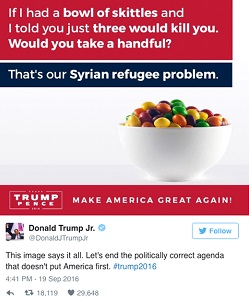
It was a Monday and 4:41 P.M. Enter stage right the on-duty social media coordinator for Skittles. Within a matter of hours, Mars’ colourful candy had become the top trending topic on Twitter. All eyes were on Skittles – my own included. What would they do, how long would it take to put together a response, get it approved internally and post it error-free under the pressure. Tweets of support flooded in as PR and social media professionals (and just generally nice people) empathized with the on-duty Skittle social media person, but the clock was ticking…
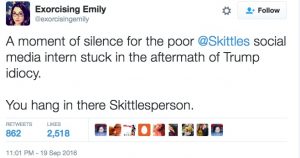
Skittles had to make a decision – and quickly.
Skittles said what?
Instead of capitalizing on the situation, Skittles smartly stepped back from the situation. Hours later, the brand’s parent company responded from their global handle with:
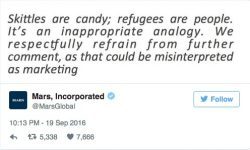
The response was short, simple, but perfect. It showed that Skittles was totally on top of taking charge of unexpected issues without turning them into reputational crises. While it can be tempting for brands to take full advantage from awkward viral situations, thinking of the bigger picture and how the story will play out is fundamental – especially when it involves politics, religion, disasters or emotive topics.
So what can brands and communicators takeaway from this?
- “Keep responses short, sweet and to the point”, Brian Bell manager brand PR, branded entertainment, and talent at Dr Pepper Snapple Group.
- Don’t overthink and complicate responses
- Avoid getting sucked into providing further commentary once you’ve released your statement
- Don’t self-promote or appear to capitalize on sensitive situations
- Emotion. Mars’ response demonstrated that they were human and not just a faceless corporate brand
Nice work Mars and social media Skittleperson!
As a Pole who spent most of her life in Belgium and recently arrived to Canada, I’ve always experienced communication through the multilingual lens. This unique experience was enhanced by my internship at the Alliance Française de Vancouver where we were regularly asked: ”How do I engage English and French communities?” In a city like Vancouver which is so multi-cultural, this is an issue we face more often than not – especially from a PR perspective.
Below are a few important aspects to keep in mind when creating an efficient multilingual/multicultural PR campaign.
Iceberg theory
The language is just the tip of the iceberg. We sometimes only concern ourselves with what is visible, or in this case audible; but language is built on a shared history, specific cultural norms, beliefs and behaviours. Or in the case of this metaphor, the invisible and more substantial part of the iceberg.
We don’t just speak a language; we experience it. It’s very difficult to artificially leverage a language without immersing ourselves in the context and the values that surround it.
A language grows and evolves within a culture, and this culture must be taken into account when we apply our PR campaign to another linguistic group. Doing PR in another language does not mean just duplicating the words. We have to take into account the social and cultural context of the people that the campaign is directed to.
Context and cultural background
While working at the Alliance Française, I was in responsible for organizing cultural events and promoting them to French and English speakers alike. I couldn’t simply translate a promotional campaign that was working well in French into English, the soul and purpose had to be translated as well.
One example, for the 60th anniversary of women’s right to vote in France, we decided to organize a conference about Simone de Beauvoir – a leading figure in French feminism during the second half of the 20th century. We found that the process was quite straightforward for the French speaking public, who were very familiar with the impact of Simone de Beauvoir. However, we had to take an additional step when promoting the event to the English speaking public who were less familiar with her. We explained who Simone de Beauvoir was in our English promotions and connected the event to the history of Canadian feminism, which proved more engaging.
This is a perfect example of why a PR campaign needs to be sensitive to its audience. Start by researching the subjects which are relevant to your audience. Then test your campaign materials on a native speaker to ensure that they are receiving the message about what the campaign is promoting. In the case of the Alliance Française, if we were assuming that all English speaking Canadians were as familiar with the French culture as Frenchmen are, we wouldn’t have been able to attract much of the English speaking public, had we not tailored our promotional materials to their needs.
“You’re welcome” is not “For nothing”
Most importantly, be aware of word-for-word translations. If you have ever used Google Translation, you might have noticed that it’s usually not the best tool to use if you want to be understood in another language. Translated literally, “you’re welcome” in French will result in “tu es bienvenu” which means ”you’re welcome to my house”, and if we translate ”de rien” (which is actually what we say for ”you’re welcome”) in English, it will become ”for nothing”, which is not really used in English.
It’s one of the most extreme examples, but it’s definitely not the only one, and it shows us that we must pay attention to different expressions when we pass from one language to another, as what is obvious for you isn’t always obvious for others.
Speaking another language means seeing the world differently, and our diversity is what makes us interesting!
Tags: multilingual communication

Chelsea Clinton at the National Democratic Convention 2016
Both of the Presidential candidate’s daughters spoke a week apart at the respective conventions. Both are young and attractive women and mothers. Both spoke with praise about their parents. For both it was the most important speech of their lives and in front of the biggest audience ever.
Chelsea Clinton talked of her mother’s love for service and her great skills and love as a mother and grandmother. In contrast Ivanka Trump’s speech was about her dad’s focus on his business career.
If you were reading the text of each speech, they both supported their parents and described what they are well known for. But that is not how TV works.
Back in 1964 Marshall McLuhan coined the phrase: “The Medium is the Message.” He wrote all about it in his most widely known book, Understanding Media: The Extensions of Man, published in 1964. McLuhan proposes that a medium itself, not the content it carries, should be the focus of study. McLuhan said that a medium affects the society in which it plays a role not only by the content delivered over the medium, but also by the characteristics of the medium itself.

Invanka Trump at the Republican National Convention 2016
So put the content of the speeches aside, and think back on how the ladies presented. One person had a clear advantage and expertise performing on TV. That was Ivanka Trump. She has co-hosted her dad’s national TV show “The Apprentice” and spoke with ease to the thousands in the stadium and the millions tuning in. She was confident, paused when she needed to and looked like she had made dozens of similar speeches before. She definitely has the training and like her dad she knows how to put on a show.
Chelsea Clinton, not so much. Chelsea has made speeches before, but she’s more tentative, not a commanding presence as all. While pleasant, she is not a forceful personality. Subtly, she came across as lacking confidence.
Donald Trump does not have a lot of substance in what he says, but his bombastic, argumentative and dominating presence his taken him to the top of the Republican ticket. None of his competitors work TV the way Trump does.
One of the big knocks on Hillary Clinton is that people don’t know who she is – they don’t know her; therefore they don’t trust her. Even when TV media are friendly to her, the TV medium is not.
Does the top TV performer always win? The Trumps hope so.
Fun to watch.
Last year I was invited to be a keynote speaker at the Canadian Public Relations Society’s (CPRS) AGM to share my public relations CSI experience on the African continent. This is my story….
Before we get started let’s clarify the definition of CSI and CSR, which are sometimes used interchangeably. CSI, or corporate social investment, is the organization’s contributions (either monetary, employee time and resources, or gifts in kind) which bring benefits over and above those directly associated with the core business activities. CSR, or corporate social responsibility, on the other hand is a corporation’s initiatives to assess and take responsibility for the company’s effects on environmental and social wellbeing such as companies “going green”.
Companies need to invest in CSI as it ensures their contribution towards building and enhancing the quality of life for the people in the communities that they operate in, both internally and externally. When companies involve themselves in CSI programs it improves the recognition of their brand and can contribute towards brand loyalty.
CSI provides a social return on investment
Corporate social investment is more than just financial spending; it can also intensify a company’s commitment to its own mission. Global pharmaceutical company, Bristol Myers Squibb (BMS), for example, launched the “Secure the Future” program in 1999 offering grants to countries in Africa for women and children living with HIV/AIDS. To date, this has made a positive and lasting difference in the lives of more than 1 million women and children. The information that BMS has access to in the pandemic, as a result of their social investment, may also prove to be helpful in their on-going research and product development.
CSI initiatives have to be sustainable to be effective
In order for a CSI initiative to be sustainable, it needs to be treated like a business initiative. It cannot merely be an investment with no financial return. Even the most innovative, well-received CSI initiatives will eventually fizzle out if not directly tied to the business motives of the company. It will only continue for as long as the company has the appetite for spending money. As soon as the economy suffers or profits drop, CSI will be the first thing to be cut from a company’s budget. CSI program stand a much better chance of survival if they are tied to the profitability and sustainability of the company itself. Therefore, due diligence should be performed on all CSI initiatives: there should be a strong business case, and like all businesses, there should be a business plan with clear, measureable outcomes.
One company that has succeeded in proving a sustainable CSI campaign that is tied to its organizational goals is McDonald’s McHappy Day. In South Africa, for instance, this is a global charity event that aims to raise money for HIV/AIDS orphanages in South Africa. In the past, celebrities have enthusiastically worked at McDonald’s restaurants nationally over one weekend to raise the targeted amount of money while customers flooded the restaurants to meet their local celebs and to buy a meal.
CSI campaigns have to be authentic to survive
CSI activities cannot be a smokescreen for an organization’s real social or environmental impacts. For example, a company that sells designer clothes that runs an excellent CSI programme aimed at looking after HIV orphans, while most of its clothes are made through child labour in textile factories that use and pollute water unsustainably and foster corruption, is not accomplishing anything but setting themselves up for scandal.
While companies can contribute through CSI initiatives, the impact is far more significant if it is integrated into its core business at a local level, such as its procurement and employment practices.
At the end of the day, a well thought out and executed CSI campaign can work wonders for one’s brand identity and help the brand achieve PR exposure far beyond their expectations. Combined with public relations, a good CSI campaign can take a company to a completely new level and even establish it as a leader and innovator in its industry. As such, companies should consider investing in a reputable CSI campaign to share the love, spread the love and organically boost their brand identity too.
Tags: Corporate social investment, corporate social responsibility, CPRS, CPRS Vancouver, CSI, CSR, Public relations
Almost every day for the past month, as we walk to and from the Peak office on Robson Street in Vancouver, we are greeted by long line ups of people excitedly waiting to get a taste of our newest neighbor, Ladurée Paris. This is not new to us Robson Street dwellers, as we have also recently witnessed the overnight Tesla line ups as well as the many line ups for Kanye West shoes. But, never have we seen it for a month straight. So, what makes Ladurée so appealing that people are willing to wait for hours day after day?
Consider these four reasons:
It starts with a story
It all starts with a strong story: one which not only shares the vision of the brand but is relatable to the audience. This is followed by a commitment to maintain and enhance that story with all other public relations efforts. The Ladurée brand story is intertwined with Parisian history and refinement, and through that story they invite the audience into their world of French luxury and elegance.
The ‘je ne sais quoi’ factor
An important question to ask once the story is defined is, “what makes your product more unique than similar products also on the market?” Ladurée has been able to differentiate themselves through the idea of authenticity, elegance and sophistication, and by being an active part of the definition of Parisian haute couture over the years through partnerships with high fashion houses and like-minded celebrities.
Old world meets new world
For any brand to be strong, it must be an important part of modern culture while still holding true to its own story and uniqueness. This is done in different ways, but most commonly through celebrity endorsement, social media, word of mouth reviews and of course, PR. From a brief sweep of the 20+ official Ladurée Instagram accounts, it is apparent that they have managed to keep the old French sophistication at the forefront, while still being culturally relevant – from creating decadent macarons based on Disney’s Frozen, to featuring celebrities such as Pharrell and Blake Lively, to partnering with Vogue magazine.
Ladurée is also the first of its kind to open in Canada, and with its choice to be on Robson Street, a street known for having high class designer shops and restaurants, it is also culturally positioning itself in Canada as being more than just another macaron shop, but a standalone designer store.
Personality always wins
The product has to appeal to their target audience and allow them to be drawn into the world the brand has created. At this point three questions must be answered – Is the brand appealing? Will I purchase it? And if so, why? In addition to a strong product, Ladurée has surpassed all expectations on this by answering all three questions. Ladurée has created an experience that is not only appealing to a wide range of people, but is an experience people are willing to pay money for in order to gain something they cannot get anywhere else. Macarons can be bought in many places, but curated Parisian culture and art cannot.
From the pretty pastels, fine china and floral patterns to the visually appealing deserts, the brand has curated a story that the public wants to not only buy into, but to share with their friends and on social media. As a result, Ladurée and other brands with similar buzz are not only accessible, but they create an experience worth coming back to, again and again.
Tags: brand, brand awareness, branding, laduree canada, laduree paris, Public relations
Donald Trump is breaking every conceivable PR101, 202 and even PR PhD rule and remains completely unaffected by it. In fact, the more he breaks the rules, the more popular he becomes. So, are those basic public relation rules that we all know outdated? His communication style is aggressive to the point of stand-up comedy; more propaganda, less public relations. But, for argument’s sake, should we throw out what we know and adopt the shoot-from-the-lip style Trump embodies – especially in the face of a crisis?
In a political nomination campaign, particularly in the United States, you can do the following, apparently without fear of law suits or reprisals:
- Attack competitors
- Call opponents liars
- Threaten to punch protestors in the face
- Be yourself – no matter what
- Make fun of the media who carry your message
Say Trump wins the election. Should you or your company adopt his style and become more aggressive in the face of attacks by the media or critics? Should you go on the offensive to try to galvanize your supporters? Should you simply thumb your nose at powerful media and treat it and your detractors with disdain?
Consider this: If “the Donald” was your CEO in a crisis and talking about your company’s critics or competitors as he is talking now about his opponents and others, how do you think it would affect your brand? I suspect his board of directors would be the first to say, “Donald, you’re fired!”
In the real world of business, you simply can’t do what “the Donald” is doing. Why? Because politics is not business reality. So, in light of Trump’s recent antics in the media spotlight, here are some lessons we can all learn:
Never attack your competitors
The first rule of good public relations is you never attack competitors. Exxon didn’t gloat publically when BP sprung a leak in the Gulf of Mexico. When Walmart parmesan cheese was found to contain cellulose recently, Safeway didn’t run attack ads about it. When you begin throwing stones it’s too easy for the media or the public to pick up some of those same rocks and toss them back at you.
Don’t call opponents liars
“The Donald” calls his opponents liars. He does this often. It’s his go-to pitch. In a heated public debate which your company may be involved in, calling opponents liars will galvanize opposition and lose you public support. When you lose your cool, you lose – period. The best strategy is to stick to your facts day in and day out and to let your facts ultimately win the day. Keep a level-head because the more nasty and out of control your opponents get, the more support you will get.
Don’t threaten to punch protestors in the face
When asked, many a CEO might agree privately, that in certain instances they’d like to punch a protester in the face. Now imagine a big project, like B.C.’s pipelines and Site C dam proposals. Imagine a CEO saying on TV, “I’d like to punch that protestor in the face.” They’d be looking for a new career immediately and the project would be dead.
You can be your own worst enemy
In Trump’s case, this means his shoot-from-the-lip style is not a good idea in a crisis. Being yourself is actually good advice for a CEO facing a crisis, as long as being yourself means you show that you care, admit your mistakes, are truthful and outline a plan to make things right. If you are shaken by what happened, allow it to show, allow your concern to show through – be human. But, if being yourself means you go on the offensive and attack everyone in your path, then save that for the boardroom.
Media don’t like to be made fun of
The media, including social media, carry your message. Making fun of media pundits, reporters, bloggers and analysts is never a good idea. It may feel to you like you are winning but the “win” is temporary. They always get the last word. You should correct factual errors they have made, point out your positive message, and then take the high road. The public is smarter than you think. They will get your message and understand when the media is being unfair.
The bottom line?
Everyone likes to copy a winner; business schools teach investment success models such as Warren Buffett’s. But, we also laud those who break the mold and go against the establishment. Case in point? Donald Trump.
If you copy Donald Trump’s nomination strategy in your business I would say that you do so at your own peril. Right now, Donald Trump doesn’t need real answers, he just needs one-liners, of which he seems to have an endless supply. When pushed into a corner he goes on a personal attack, calls someone a liar, raises a boogeyman or mentions 9-11.
A nomination campaign is not the business world or even the real world. It is more like reality TV. There is only one measuring stick: winning, and the focus is extremely short term. There is no tomorrow.
Successful businesses have a long time horizon to consider because the public won’t forget and you don’t get to completely rebrand every four years like a political party does. Unlike a new political leader, a new CEO doesn’t make all the old negative news magically disappear.
Tags: crisis communications, donald trump, media relations, Public relations
Out with the old, in with the new
Looking back on nearly two decades of public relations work following a 30-year career as a news reporter provides an opportunity to reflect on how PR and the media interact in 2016. The new reality for the news media is there are now fewer people employed to do what, in many cases, is much more work.
After a series of buyouts of senior people, The Vancouver Sun and The Province announced earlier this year that they are merging their newsrooms. What does this mean for PR? Less competition and fewer people to cover news.
Television news that once was confined to slots at noon, supper hour and late newscasts is now delivered 24 hours a day in back to back ‘news wheel’ formats that stretch reporters, editors and videographers to new limits.
A new media frontier
The power of the internet continues to grow, with bloggers having as much or more impact than reporters for mainstream media.
So how does this impact the ability of companies, organizations and public relations professionals to get the message out in the media?
Simply put, the media landscape may have changed dramatically but there are more opportunities and channels than ever for publicity.
Everybody is talking about Donald Trump
Love him or hate him, Trump is a publicity machine. He is getting more media attention than anyone else on earth with radio, television, newspapers and social channels featuring what seems to be a play-by-play of Trump’s latest antics in the Republican presidential candidate race.
Getting noticed still makes or breaks reputations, makes the cash register ring and brings people to the door.
And so, getting your message out with ‘earned’ media – otherwise known as public relations – is still one of the best ways to become known. Although the number of reporters may be contracting, newspapers and television are still hungry for content. The number of social channels grows every day. Trade magazines also abound and every industry is supported by at least one that’s looking for stories.
Do-it-yourself
If you can’t get the media to tell your story through positive news coverage, do it yourself. Have videos produced and tell the story of your own company, your product or your services with words and pictures that matter to your brand. Then, feature it on your website.
Do something amazing and put it on the web via Youtube, Vimeo or Instagram. Send this to everyone you know. If your story goes viral, everyone will know what you want to get across and good things can happen.
Tags: donald trump, media relations, new media, Public relations, social media
This year’s BCAMA annual marketing agency panel did not disappoint. Expert speakers from top agencies provided a strong sense of what’s to come this year and created a healthy debate around what’s really going to be some of the key drivers. There was a ton of information relayed to the hundreds of branding and communications professionals in the audience. Here are few of the highlights we took away with us.
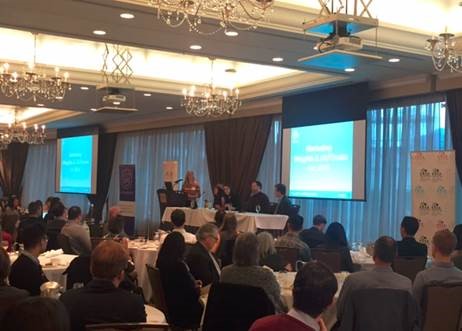
Speaker #1: Andrew McCarthy – President, Tribal Worldwide Canada
The theme of Andrew’s presentation was around using content to connect with consumers. Research has recently shown that 71% of consumers who have blocked ads have said they’d consider whitelist advertising if the content was decent. Basically, people hate bad advertising.
So, how do you increase the shareability of your content?
- Relatability – your content must be relevant
- Have a point of view – this will help streamline content and ensure it’s consistent and interesting
- Findability – search rankings are key when it comes to content dissemination
- Mobility – make sure your content is where your audience is hanging out
- Likeability – it’s an obvious one but your audience has to want to genuinely share your content
Snack Time, the milk producers of Western Canada’s cartoon series, was shared as a successful campaign where all the above was put in motion.
Speaker #2 Kelly Stephenson – Director of Strategy, Creature Agency, Seattle
Kelly’s talk centred around the prediction that there will be a rebalance between data and “creative bravery”. Kelly acknowledged the importance of data but cautioned that often marketers can get so caught up in data that the ability to connect with consumers is lost. Her argument around brands not becoming too obsessed with data was effectively summarised when she said, “data looks backwards; insights look forwards.” Marketers need to consider data and use this to create consumer insights in order to produce relevant and creative narratives that will increase the value of the relationship between brand and consumer.
An example used to highlight this argument was REI and its decision to shut up shop for the day on Black Friday and encourage its followers to #optoutside. REI chose to prioritize its shared values with its Millennial audience, putting a short-term need (a lot of revenue on Black Friday) behind the longer-term relationship. It was a smart move as the retailer generated millions of media impressions and a significant amount of content and engagement around #optoutside.
Speaker #3 April Yao – Senior Account Manager, 6S Marketing & Sheng Li Digital
April got up on stage and immediately said she had to disagree with some of Kelly’s points as 6S still uses and responds to data to ensure successful client campaigns that are closely tracked and clearly show ROI. April primarily presented on two topics: retargeting (also known as remarketing) and marketing to the Chinese population. April discussed the virtues of retargeting and dynamic remarketing (getting specific products that someone has already looked at on your brand website in front of the user when they are viewing another site). She said that, if you follow the cost per click (CPC) model, you’ll see the value quickly.
On the Chinese front, April said that approx. 20% of the Vancouver population is Chinese and encouraged the marketers in the room not to forget this growing market which often has high spending power. She talked about some of the equivalent Chinese social sites such as Youku (video), Baidu (search), and Weibo (think Twitter and micro-blogging).
April gave the example of Cirque du Soleil and how they were selling tickets fast in the English-speaking Vancouver community but not in the Chinese community. Through a Weibo contest, creating a Chinese landing page and a retargeting campaign, Cirque saw a significant increase in its ticket sales. Her final point on this community was that ethnic markets shouldn’t be forgotten but they also require their own distinct strategy.
Speaker #4 Dan Scherk – Partner & Creative Director, Traction Creative
Finally, Dan Scherk took to the stage to discuss the importance of brands adopting a user-centric approach in their marketing campaigns. He talked about how social marketing in particular has proven how brands cannot be organization-centric and that they have to prioritize user needs. Using his psychology background, he delved into social marketing behavioural theories and touched upon reasoned action approach, a benchmark for understanding and predicting human behaviour. Dan emphasised the need for marketers to tap into consumers’ beliefs, showing how that would impact attitudes which would in turn formulate intentions and lead onto certain behaviours.
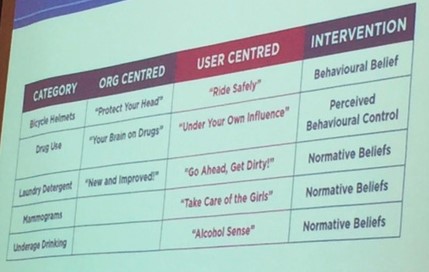 The last case study of the morning was an interesting one: it was the “Dumb Ways to Die” campaign that was launched by Metro in Melbourne, Victoria. The cartoon campaign series was focused on reducing the number of accidents on its trains. Based on this, it was extremely successful and resulted in a 20% reduction in accidents. The campaign won top industry awards and was hailed a great success by many. But it was viewed as a failure by others. Why? In the real world, the true issue was suicide. So, a successful user-centred approach would have been around suicide prevention. Instead, the brand took an organizational approach and focused on an issue that was not the real problem.
The last case study of the morning was an interesting one: it was the “Dumb Ways to Die” campaign that was launched by Metro in Melbourne, Victoria. The cartoon campaign series was focused on reducing the number of accidents on its trains. Based on this, it was extremely successful and resulted in a 20% reduction in accidents. The campaign won top industry awards and was hailed a great success by many. But it was viewed as a failure by others. Why? In the real world, the true issue was suicide. So, a successful user-centred approach would have been around suicide prevention. Instead, the brand took an organizational approach and focused on an issue that was not the real problem.
Finally, the panel moderator, Claire Booth of Lux Insights, said that, while #FOMO (fear of missing out) was a real thing last year, this year, it’s apparently going to be all about #FOLO (fear of living offline).
Tags: bcama, featured, marketing, media relations, Peak Communicators
Social media is central to many of our campaigns at Peak. We consume news about the impact these channels have and apply our learnings to client projects.
If you’re still struggling to get buy-in on social media, this list of 30 facts provides useful need-to-knows on why engagement is important.
Did You Know?
- Over 75 percent of all internet users use social media (source: Makeuseof)
- 71 per cent of women use social media compared to 62 percent of men (source: SearchEngineJournal)
- 91 percent of brand mentions on social media come from people with fewer than 500 followers and 94 percent of those mentions are positive (source: Business2Community)
- 21 percent of consumers will unfollow brands that post repetitive or boring content (source: Social Times)
- 89 percent of 18-29 year age group use social media (source: smallbusinesscan) and 84 percent of C-level/VP execs use social media to support purchase decisions (source: smallbusinesscan)
Facebook:
- Facebook accounts for 21 percent of all social media referral traffic globally (source: TechCrunch)
- Facebook drives 23 percent of all traffic across the internet! (source: Shareaholic)
- 189 million of Facebook’s users are ‘smartphone only’ (source: wersm)
- 23 percent of users check their accounts at least five times a day (source: SearchEngineJournal)
Pinterest:
- 80% of pins are actually re-pins (source: Mashable)
- Shoppers referred to a site from Pinterest are 10 percent more likely to buy (source: Socialmediatoday)
- Pinterest referrals spend 70 percent more money than visitors referred from non-social channels (source: Socialmediatoday)
- Pins with a call to action increase engagement by 80 percent (source: Socialmediatoday)
- 80 percent of Pinterest users are women; 50% of all users have children (source: Socialmediatoday)
Twitter:
- The fastest growing group of new users on Twitter are aged between 55 and 64 years (source: wersm)
- 65 percent of users expect a response on Twitter in less than two hours (source: SearchEngineJournal)
- 88 percent of Twitter users are on mobile and 500 million tweets are posted each day (source: Jeff Bullas)
LinkedIn:
- LinkedIn has nearly a quarter of a billion users (source: smallbusinesscan)
- Only 20 percent of LinkedIn users are under the age of 30 (source: SearchEngineJournal)
- 40 percent of B2B buyers say LinkedIn is important when researching technology and services to purchase and 65 percent of B2B companies have acquired a customer through this channel (source: business2community)
Instagram:
- More than 70 million photos and videos are sent daily (source: Hootsuite)
- 53 percent of internet users aged 18-29 use Instagram (source: Jeff Bullas)
- Instagram is considered the most important social network by 32 percent of American teens (source: Hootsuite)
- Among top brands Instagram has been adopted by 85 percent (source: Hootsuite)
- Brands on Instagram are seeing a per follower engagement rate of 4.21 percent – that’s statistically 58 times higher than Facebook and 120 times higher than Twitter (source: Hootsuite)
- Still photos are more popular on Instagram than videos – generating 36 percent more likes (source: Hootsuite)
- Posts with at least one hashtag average 12.6 percent more engagement and posts tagged with a location receive 79 percent higher engagement (source: Hootsuite)
Google+:
- 18 percent of marketers plan to increase efforts on Google+ this year (source: SearchEngineJournal)
- The +1 button is hit 5 billion times per day (source: Jeff Bullas)
- Google+ has more than 2.5 billion users but only 10 percent are active (source: smallbusinesscan)
Tags: facebook, Google+, Instagram, LinkedIn, Pinterest, social media, Twitter
Social media is still a relatively new phenomenon and the features are constantly being updated. PR professionals should consider how these changes impact or enhance their campaigns.
Below is a round-up of recent ‘need to know’ social media news this fall.
Dislike is the new thing
Facebook announced that soon a ‘dislike’ button will launch. Mark Zuckerberg explained that the new function would allow people to show ‘empathy’.
Brands need to pay attention to this; consumers will be able to voice their dislike for campaigns with a simple click of a button. Brands will make headlines for the wrong reasons when a campaign backfires as a result of this function.
Purchasing power
Twitter is making its ‘Buy’ button available to everyone in the US, as a result of a partnership with Stripe. This is great news for online retailers and enhances the importance of Twitter as a customer service channel – the more followers you have, the more likely customers are to make an instant purchase.
The value for this activity will be measurable based on sales directly through the Twitter platform – this will make it easier getting buy-in for social media at the executive level.
Retailers should enhance their social media plans to develop an engaged, relevant and sizeable following on Twitter as a result.
Numbers count
Pinterest announced in September that it had hit the 100 million users’ milestone. Out of this number, around 70 per cent are considered to be ‘actively’ engaged. The company also confirmed that while Pinterest users are predominantly women, the gender gap is closing month by month.
The benefit of Pinterest for brands is people are often browsing the site for items they potentially want to buy; it is often treated like a shop window. Advertisers can proactively pay for promotional pins now and this feature will become more valuable as the number of users grow.
Pose for a portrait
Instagram is moving away from simply showcasing square images; now users can choose to post portrait or landscape photos. This is generally better for brands. Images won’t need to be compromised to fit the square frames, and will be better for accommodating specific brand guidelines.
At Peak Communicators we monitor for these social media updates daily and consider how they can be used in client campaigns. We’ll continue to share relevant updates via this blog and also our social media channels (Facebook, Twitter, Linkedin).
Tags: Vancouver PR, Vancouver public relations, Vancouver social media







